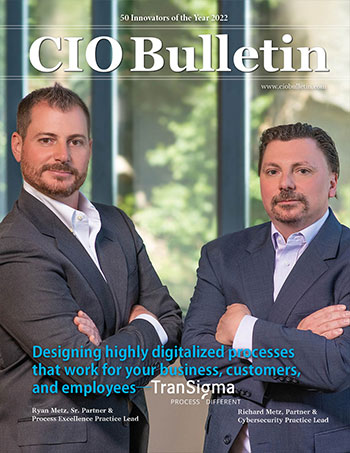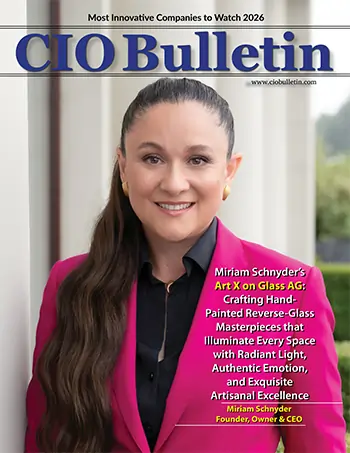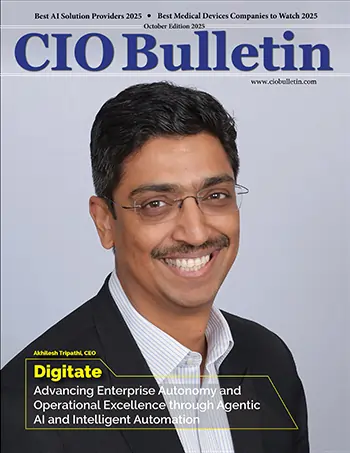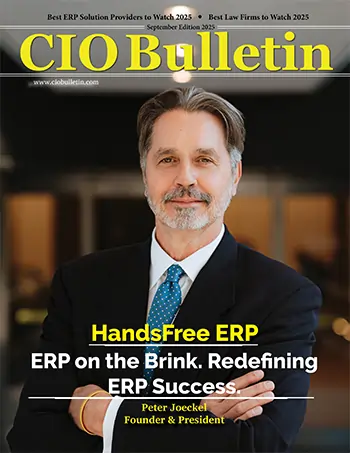50 Innovators of the Year 2022
CIO Bulletin

A brilliant strategy, blockbuster product, or breakthrough technology can put you on the competitive map, but only solid execution can keep you there. You have to be able to deliver on your intent. Unfortunately, by their own admission, most firms are not very good at it. Execution is the result of thousands of decisions made daily by employees acting according to the information they have and their self-interest.
More and more organizations accelerate digital transformation initiatives. They require efficient ways of analyzing and monitoring their business processes. Traditional, manual-based processing models are effective but can be massive undertakings and omit valuable data. The worst bottlenecks are often hidden. You might have an instinct or gut feeling that something is slowing productivity, but without data, it’s challenging to back up those assumptions.
Organizations—from Big Tech to lean startups—can only approach maximum efficiency and make critical business process improvements when they understand how their workflows truly work. Humans alone can’t perform this data extraction and analysis fast enough to make their organizations competitive. Process mining technology allows IT service management firms to dive deeper, drilling down to uncover inefficiencies and improve them.
With process mining, organizations can expose what’s happening in their processes instead of operating under assumptions. They can then identify the root causes of bottlenecks in real-time, optimize their resources, and scale with total productivity and confidence.
Also, many organizations are undergoing significant changes in their structure and management to stay alive in today’s highly competitive environment. Hence, several firms are undertaking Business Process Reengineering (BPR) to bring the much-needed innovations to change the outdated business processes.
There have long been a few fundamental challenges associated with business process management. Two of the most troublesome problems are partially responsible for the fact that process management and improvement is, among many companies, a back-burner issue. But relatively new and innovative technologies, process mining, and process reengineering can solve both problems and revitalize process management in firms that have lain fallow for years.
If you are considering looking for process management consulting but are unsure how it might play out, look no further than TranSigma. Process is the center of TranSigma’s universe. The firm recognizes that, in today’s 4th Industrial Revolution, people and digitization are the essences of the process.
TranSigma uses Lean, Agile, Six Sigma, and other world-class process improvement techniques to streamline and digitize new process designs. Specialized, in-house functional skills are fully integrated into every aspect. The firm’s program management expertise is then utilized to lead, manage and execute those changes. Throughout, TranSigma’s change management experts work to ensure stakeholders, employees, and customers fully engage in the transition.
TranSigma experts have served clients across many industries, including Consumer Products, Financial Services, Pharmaceuticals, Insurance, Banking, and Technology.
In conversation with Richard Metz, Partner and Cybersecurity Practice
Lead at TranSigma, and Ryan Metz, Sr. Partner and Process Excellence Practice Lead at TranSigma
Q. How do you successfully provide innovative solutions for customers and clients?
We continuously look for ways to improve our clients’ businesses, and much of our innovation comes from solving our customers’ problems. We believe that most business challenges are not bespoke issues or ‘things’ but rather the result of underperforming or underdefined processes. Much of our work involves improving processes and proving processes should exist where ad hoc or non-standard approaches are currently in use.
Q. Are the decision-making and organizational mobilization processes quick enough to bring innovations to the market ahead of your competitors?
Internally, we are a virtually flat and egalitarian company. We have little tolerance for anything that would inhibit the growth and development of beneficial ideas. In innovating for our clients, we use every opportunity to improve or prove processes in line. For example, many of our programs involve significant changes in large enterprises. We’ve always found ways—sometimes significantly—to improve overall collaboration and communication as part of these activities.
Q. How efficient is your organization from an operational standpoint?
We are 100% client-focused, meaning that nearly all our internal investment is geared directly towards delivering exceptional customer service. We also focus strongly on leveraging non-client employee time on pursuits that benefit and interest both the employee and the business—such as training, certifications, and developing our in-house suite of transformation tools.
Q. How well does your organization utilize its people as an asset to help it improve, stay competitive, and strategically meet goals?
As a consultancy, our people are our primary asset. We foster a customer-centric service culture and encourage everyone’s ideas to improve our business and the value we deliver to our clients. Our mantra is that “every client interaction is an opportunity to provide value.” That extends well beyond the delivery of whatever project or program we’re engaged in—any knowledge we have is at our customers’ disposal.

Tell us more about how you streamline and digitize new process designs.
The key is “alignment.” Many process design or redesign failures occur because we haven’t adequately considered the desires and capabilities of the process subjects. Often, leaders lean on implementing a product or solution to “solve” a problem, only to find that alignment problems prevent people from getting optimal value or fully utilizing that tool. People respond best to changes that allow them to understand and be energized by the path from as-is to to-be, as they are the drivers of the improvement.
Q. How do you measure success at a client?
The boring (though essentially correct) answer is that we have enabled our clients to achieve their business goals. C-Suite and board member sponsors correlate directly to business value—increased revenue and/or reduced cost or risk. Deeper within large organizations, our goal—aside from engagement objectives—is to help teams and leaders find more success in their careers and collaboration. Nothing makes me happier than helping a sponsor get a promotion or recognition for their work or to see previously confrontational groups and people finding productive, common ground.
Q. How have your skillsets helped you reach this stage?
Ryan and I started our careers as GE Capital IMLPs (Information Management Leadership Program) in the early 2000s—one of the world’s most respected technology leadership programs. It provided us with an outstanding education in technology, leadership, and the dynamics of large organizations. Entering the entrepreneurial world was, in the early days, a little “school of hard knocks.” Still, it has delivered a true “well-rounded” experience that enables us to succeed in driving change at organizations of any size and in virtually any industry.
Shed more light on how you lead transformation across many areas of businesses.
This is where entrepreneurship has provided us with the best lessons. When we address internal challenges, we know that the impact directly hits our bottom line and, therefore, our paychecks. It’s much easier for smaller companies to align business decisions with business value. In large organizations, politics and perception often drive decisions. We want to acknowledge that this is OK! Politics are probably essential and inevitable when many people come together to achieve common goals. We always seek ways to eliminate confrontation and develop solutions that make every stakeholder a hero. It is never a zero-sum game—we really can have multiple winners!
Give me one more innovation coming down the pike.
We’re currently investing a lot of time and effort into VMaaS. We’re working with our exceptional partners on a Cybersecurity “Vulnerability Management as a Service” offering. It will be a catalog of nearly 60 micro-services that allow clients to fill gaps, or it can be an end-to-end offering. Vulnerability management is typically defined as addressing enterprise software deficiencies—including operating systems, 3rd party software, and bespoke software. It is one of the least efficient undertakings we’ve found. Still, it is also a tremendous “nucleus project”—meaning that if you get vulnerability management right, you will resultantly improve many other related areas—such as IT Asset Management, License Management, Infrastructure Operations, User Experience, and even core stakeholder management.
Leading TranSigma to excel in providing project management services
Richard Metz is a partner and Cybersecurity Practice Lead at TranSigma. He began his career at GE Capital and worked primarily in GE’s Consumer Finance business, leading to roles in the U.S., Germany, and the United Kingdom. Richard joined TranSigma upon returning to the US in 2014. He has developed several successful consultancy offerings in the areas of Cybersecurity, Process Transformation, and Global Outsourcing. He is a champion of people in large organizations who have great ideas but need help in getting them recognized and realized.
Ryan Metz is a senior partner and Process Excellence Practice Lead at TranSigma. Ryan Metz began his professional career with GE’s technology leadership program and joined TranSigma in 2010. Ryan has developed and delivered successfully to clients in virtually every industry, including banking, insurance, pharmaceutical, manufacturing, and consumer products. He and his teams have delivered innovations across corporate governance, PMO execution, shared services, legal, and cybersecurity. He is passionate about breaking down barriers and generating strategic momentum to deliver business value.
“Looking for that simple, brilliant process? That’s where we come in.”







